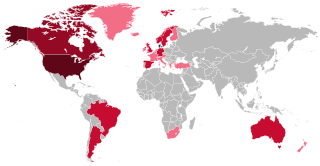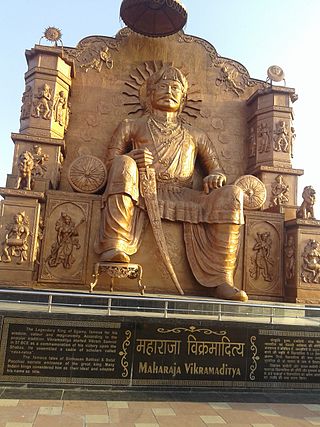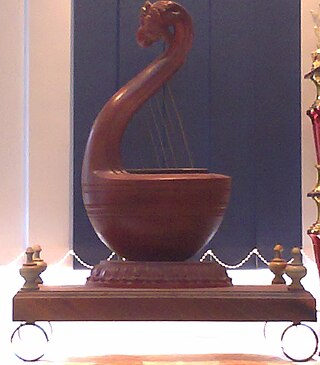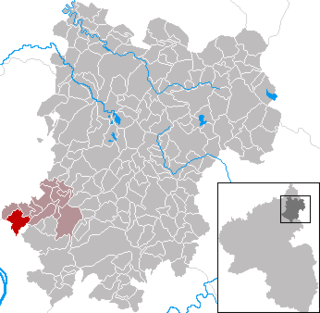Sources
- Arias, Jorge C. "Identity and Interactions: The Suevi and the Hispano-Romans." University of Virginia: Spring 2007.
| Preceded by | Suevic King of Galicia sixth century | Succeeded by |
Theodemund was a Suevic King of Galicia between the years 469 and 550. This period is very obscure and little is known about the rulers in this time save that they were Arians. The hypothesis of his existence is based on a twelfth-century document that mentions a Theodemundus ruling the Sueves between Remismund and Theodomir. Because this mention occurs in a listing of seventh-century ecclesiastical divisions at the time of Wamba, Wilhelm Reinhart believes it was based on an earlier source.

The terms anno Domini (AD) and before Christ (BC) are used to label or number years in the Julian and Gregorian calendars. The term anno Domini is Medieval Latin and means "in the year of the Lord" but is often presented using "our Lord" instead of "the Lord", taken from the full original phrase "anno Domini nostri Jesu Christi", which translates to "in the year of our Lord Jesus Christ". The form "BC" is specific to English, and equivalent abbreviations are used in other languages: the Latin form, rarely used in English, is Ante Christum natum (ACN) or Ante Christum (AC).

The Hebrew calendar, also called the Jewish calendar, is a lunisolar calendar used today for Jewish religious observance and as an official calendar of Israel. It determines the dates for Jewish holidays and the appropriate public reading of Torah portions, yahrzeits, and daily Psalm readings, among many ceremonial uses. In Israel, it is used for religious purposes, provides a time frame for agriculture, and is an official calendar for civil holidays alongside the Gregorian calendar.

The Saxons were a group of Germanic peoples whose name was given in the early Middle Ages to a large country near the North Sea coast of northern Germania, in what is now Germany. In the late Roman Empire, the name was used to refer to Germanic coastal raiders, and in a similar sense to the later "Viking". Their origins are believed to be in or near the German North Sea coast where they appear later, in Carolingian times. In Merovingian times, continental Saxons had been associated with the activity and settlements on the coast of what later became Normandy. Their precise origins are uncertain, and they are sometimes described as fighting inland, coming into conflict with the Franks and Thuringians. There is possibly a single classical reference to a smaller homeland of an early Saxon tribe, but its interpretation is disputed. According to this proposal, the Saxons' earliest area of settlement is believed to have been Northern Albingia. This general area is close to the probable homeland of the Angles.

The Alans were an ancient and medieval Iranian nomadic pastoral people of the North Caucasus – generally regarded as part of the Sarmatians, and possibly related to the Massagetae. Modern historians have connected the Alans with the Central Asian Yancai of Chinese sources and with the Aorsi of Roman sources. Having migrated westwards and becoming dominant among the Sarmatians on the Pontic–Caspian steppe, the Alans are mentioned by Roman sources in the 1st century CE. At that time they had settled the region north of the Black Sea and frequently raided the Parthian Empire and the Caucasian provinces of the Roman Empire. From 215 to 250 CE the Goths broke their power on the Pontic Steppe.

The Rugii, Rogi or Rugians, were a Roman-era Germanic people. They were first clearly recorded by Tacitus, in his Germania who called them the Rugii, and located them near the south shore of the Baltic Sea. Some centuries later, they were considered one of the "Gothic" or "Scythian" peoples who were located in the Middle Danube region. Like several other Gothic peoples there, they possibly arrived in the area as allies of Attila until his death in 453. They settled in what is now Lower Austria after the defeat of the Huns at Nedao in 454.

Srivijaya was a Buddhist thalassocratic empire based on the island of Sumatra, which influenced much of Southeast Asia. Srivijaya was an important centre for the expansion of Buddhism from the 7th to the 11th century AD. Srivijaya was the first polity to dominate much of western Maritime Southeast Asia. Due to its location, Srivijaya developed complex technology utilizing maritime resources. In addition, its economy became progressively reliant on the booming trade in the region, thus transforming it into a prestige goods-based economy.

Danes are an ethnic group and nationality native to Denmark and a modern nation identified with the country of Denmark. This connection may be ancestral, legal, historical, or cultural.
Tolkāppiyam, also romanised as Tholkaappiyam, is the most ancient extant Tamil grammar text and the oldest extant long work of Tamil literature. It is the earliest Tamil text mentioning Gods often identified as Hindu deities. Mayyon as, Seyyon as (Skandha), Vendhan as (Indra), Varuna as (Varuna) and Kotṟavai as are the gods mentioned. The surviving manuscripts of the Tolkappiyam consists of three books (atikaram), each with nine chapters (iyal), with a cumulative total of 1,610 (483+463+664) sutras in the nūṛpā meter. It is a comprehensive text on grammar, and includes sutras on orthography, phonology, etymology, morphology, semantics, prosody, sentence structure and the significance of context in language.

Prithviraja III, popularly known as Prithviraj Chauhan or Rai Pithora, was a king from the Chauhan (Chahamana) dynasty who ruled the territory of Sapadalaksha, with his capital at Ajmer in present-day Rajasthan. Ascending the throne as a minor in 1177 CE, Prithviraj inherited a kingdom which stretched from Thanesar in the north to Jahazpur (Mewar) in the south, which he aimed to expand by military actions against neighbouring kingdoms, most notably defeating the Chandelas.
The Gutones were a Germanic people who were reported by Roman era writers in the 1st and 2nd centuries to have lived in what is now Poland. The most accurate description of their location, by the geographer Ptolemy, placed them east of the Vistula river.

The Chola dynasty was a Tamil dynasty in southern India. At its height, it ruled over an expansive maritime empire known as the Chola empire. The earliest datable references to the Chola are from inscriptions dated to the 3rd century BCE during the reign of Ashoka of the Maurya empire. The Chola empire was at its peak and achieved imperialism under the Medieval Cholas in the mid-9th century CE. As one of the Three Crowned Kings of Tamilakam, along with the Chera and Pandya, the dynasty continued to govern over varying territories until the 13th century CE.

Vikramaditya was a legendary king mentioned in ancient Indian literature, featuring in traditional stories including those in Vetala Panchavimshati and Singhasan Battisi. Many describe him as ruler with his capital at Ujjain. "Vikramaditya" was also a common title adopted by several monarchs in ancient and medieval India, and the Vikramaditya legends may be embellished accounts of different kings. According to popular tradition, Vikramaditya began the Vikrama Samvat era in 57 BCE after defeating the Shakas, and those who believe that he is based on a historical figure place him around the first century BCE. However, this era is identified as "Vikrama Samvat" after the ninth century CE.

Rarh region is a toponym for an area in the Indian subcontinent that lies between the Chota Nagpur Plateau on the West and the Ganges Delta on the East. Although the boundaries of the region have been defined differently according to various sources throughout history, it is mainly coextensive with the state of West Bengal, also comprising parts of the state of Jharkhand in India. Linguistically, the region is defined with population speaking the Rarhi local Bengali dialect.

Longuyon is a commune in the Meurthe-et-Moselle department in the Grand Est region of north-eastern France. The inhabitants are called Longuyonnais.

The ancient Tamil music is the historical predecessor of the Carnatic music during the Sangam period spanning from 500 BCE to 200 CE.

Heraclea Minoa was an ancient Greek city of Magna Graecia situated on the southern coast of Sicily near the mouth of the river Halycus, 25 km west of Agrigentum. It is located near the modern town of the same name in the comune Cattolica Eraclea in Italy.

Nauort is an Ortsgemeinde – a community belonging to a Verbandsgemeinde – in the Westerwaldkreis in Rhineland-Palatinate, Germany.

Norse, Nordic, or Scandinavian mythology is the body of myths belonging to the North Germanic peoples, stemming from Old Norse religion and continuing after the Christianization of Scandinavia, and into the Nordic folklore of the modern period. The northernmost extension of Germanic mythology and stemming from Proto-Germanic folklore, Norse mythology consists of tales of various deities, beings, and heroes derived from numerous sources from both before and after the pagan period, including medieval manuscripts, archaeological representations, and folk tradition. The source texts mention numerous gods such as the thunder-god Thor, the raven-flanked god Odin, the goddess Freyja, and numerous other deities.
The Yavanarajya inscription, also called the Maghera Well Stone Inscription, was discovered in the village of Maghera, 17 kilometers north of Mathura, India in 1988. The Sanskrit inscription, carved on a block of red sandstone, is dated to the 1st century BCE, and is currently located at the Mathura Museum in Mathura. The inscription notes the donation of a water well and tank to the community in 1st century BCE, built by a Brahmana.